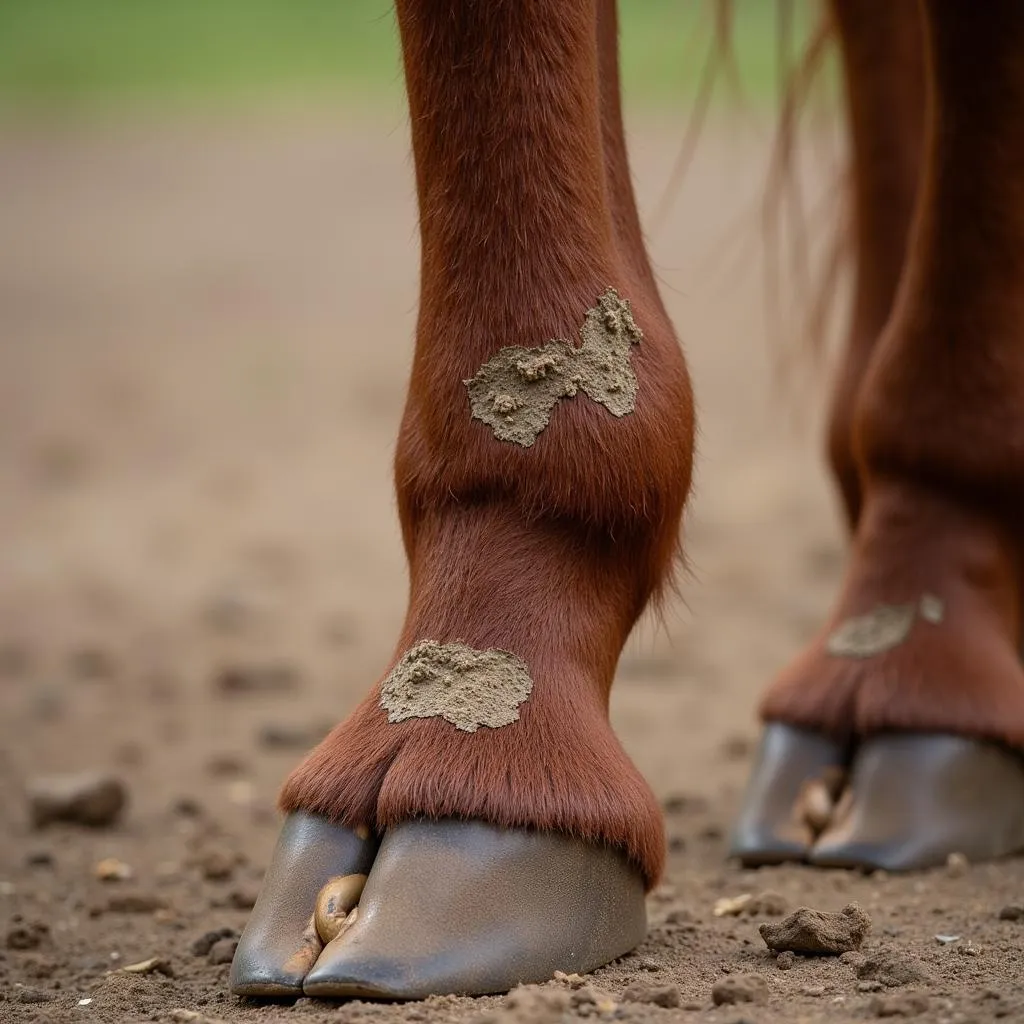White, crusty stuff on your horse’s legs can be a common sight, but is it something to worry about? While it can be caused by a variety of things, some are harmless, while others can be serious.
This article will delve into the different causes of white stuff on horse legs, help you identify the issue, and guide you through effective treatment options. We’ll also discuss preventive measures to keep your horse’s legs healthy and free from these pesky white patches.
What Causes White Stuff on Horse Legs?
Several factors can contribute to white stuff on horses’ legs. Some common causes include:
1. Sweat and Mud
Often, the white stuff on your horse’s legs is simply dried sweat and mud. Horses sweat profusely, especially during exercise or hot weather. When this sweat mixes with mud, it creates a sticky residue that dries into a crusty, white film.
“It’s important to note that dried sweat and mud can be mistaken for other skin conditions, so it’s best to consult with your veterinarian if you’re unsure.” – Dr. Sarah Jones, Equine Veterinarian
2. Scratches
Scratches, also known as dermatophilosis, is a bacterial infection that affects the lower legs of horses. It’s characterized by crusty, scabby patches, often accompanied by hair loss and inflammation.
 Scratches on horse legs
Scratches on horse legs
3. Rain Rot
Rain rot, caused by the bacterium Dermatophilus congolensis, is another common skin infection affecting horses. It presents as crusty, scabby lesions, typically on the back and legs, particularly areas that have been exposed to rain and mud.
4. Ringworm
While less common, ringworm, a fungal infection, can also cause white patches on horse legs. It’s characterized by circular, raised lesions with a scaly, crusty appearance.
5. Other Conditions
While less frequent, other conditions like allergies, mites, and hormonal imbalances can also contribute to white patches on horse legs.
Identifying the Cause
To determine the root cause of the white stuff on your horse’s legs, it’s crucial to consider factors like:
- Location: Does the white stuff appear primarily on the lower legs, the back, or other areas?
- Appearance: Is the white stuff crusty, scaly, or flaky? Are there any other symptoms like hair loss, inflammation, or swelling?
- History: Has your horse been exposed to mud, rain, or other environmental factors that could have triggered the condition?
Treating White Stuff on Horse Legs
The treatment for white stuff on horse legs depends on the underlying cause. Here’s a general approach:
- Mild Cases: For minor cases of dried sweat and mud, simply brushing your horse’s legs with a damp cloth can remove the white residue.
- Scratches and Rain Rot: These bacterial infections require treatment with antibiotics. Your veterinarian can prescribe the most appropriate antibiotic for your horse’s situation.
- Ringworm: Ringworm is treated with antifungal medications. Your veterinarian will recommend the best course of treatment for your horse.
- Other Conditions: Treatment for allergies, mites, and hormonal imbalances varies depending on the specific condition. Your veterinarian can provide a diagnosis and recommend the most effective course of treatment.
Preventive Measures
Here are some tips to prevent white stuff from appearing on your horse’s legs:
- Regular Grooming: Brushing your horse’s legs regularly helps remove dirt, sweat, and mud.
- Clean Stall: Keep your horse’s stall clean and dry to minimize exposure to bacteria and fungi.
- Avoid Wet Pasture: Limit your horse’s exposure to wet pastures, as this can contribute to rain rot and scratches.
- Fly Control: Flies can carry bacteria and fungi, so using fly repellent can help prevent infections.
- Proper Nutrition: A balanced diet helps maintain your horse’s immune system and overall health.
- Prompt Treatment: If you notice any signs of infection or skin abnormalities on your horse’s legs, consult with your veterinarian immediately.
Frequently Asked Questions
1. Is it normal for horses to have white stuff on their legs?
While it’s not uncommon for horses to have white stuff on their legs, it’s essential to identify the cause. If you’re unsure, consult with your veterinarian.
2. How do I know if it’s just sweat and mud or something more serious?
Consider the location, appearance, and any accompanying symptoms. If the white stuff is just dried sweat and mud, it’s usually easy to remove with a damp cloth. But, if it’s crusty, flaky, or accompanied by hair loss, inflammation, or swelling, it could be a sign of a more serious condition.
3. Can I use human shampoos or soaps to wash my horse’s legs?
No, it’s not recommended. Human products are not formulated for horses and can be harmful to their skin. Use only horse-specific shampoos and conditioners.
4. How often should I groom my horse’s legs?
It’s a good idea to brush your horse’s legs daily, especially after exercise or exposure to mud or water.
5. What should I do if my horse’s leg is infected?
Contact your veterinarian immediately. They can diagnose the infection and prescribe the appropriate treatment.
Conclusion
While white stuff on your horse’s legs can be a common occurrence, it’s vital to stay vigilant and address the underlying cause. By identifying the problem, providing proper treatment, and implementing preventative measures, you can keep your horse’s legs healthy and free from these pesky white patches. Remember, early detection and prompt veterinary attention are crucial for preventing complications and ensuring your horse’s well-being.
Remember, if you have any questions or concerns about your horse’s health, consult your veterinarian. They can provide personalized advice and ensure your horse receives the best possible care.